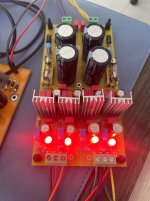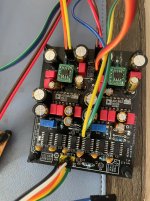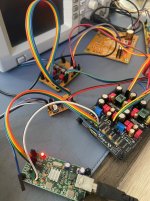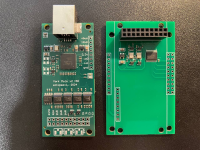@diyiggy In my Lattice box is this device for programming 😀 https://www.ebay.com/itm/274419711217
... maybe some universal jtag can work, but I never tried it 😉
... maybe some universal jtag can work, but I never tried it 😉
AD1862 Sounds great! @miro1360 Thank you very much!
The next task is to cnc a nice aluminum alloy casing for it.
The next task is to cnc a nice aluminum alloy casing for it.

Attachments
Glad to see how many AD1862 DACs are born and more and more await revival 

Indeed Miro!
Did you ever think your first post would generate such interest that 10,000+ posts, dozens of DACs born and countless side projects would follow?
Congratulations my friend!!🎉
And no signs of slowing down….

Did you ever think your first post would generate such interest that 10,000+ posts, dozens of DACs born and countless side projects would follow?
Congratulations my friend!!🎉
And no signs of slowing down….

@Vunce I didn't expect that, but you said it 🤣
I thought I would plant a small tree here and it grew into a big tree with lots of little branches, but the main branch is still AD1862 touching clouds
I thought I would plant a small tree here and it grew into a big tree with lots of little branches, but the main branch is still AD1862 touching clouds

My family tazered me after I made 5 proto pcb more for the AD1862. 🤣
Preparing for the PCM63 build 🙂 3 pcb levels is a bit ugly but at least there will be proper isolation and reclock 🙂

There will be at least one more in the near future here. passive420 was kind enough to sell me one of his Dark LED I/V's, and a JLsounds AD1862 board with no I/V section. I picked up the DAC chips from one of passive's previous links at aliexpress.

With that said, I need to figure out power supplies. Hoping people can lend some insight here. I know there are several available options, but I wanted to try to keep things compact, and I am looking at developing a mostly SMD (but still hand solderable if needed) all-in-one PSU, one transformer, one board, several regulated outputs for the necessary components the DAC requires. I would of course split that off into it's own thread, but I need some insight on what kind of sizing I would need for a transformer. I think using something like a Talema 70054k with dual 18VAC secondaries would get me enough voltage to split off several regulated voltages after rectification, I am just unsure on transformer size. 15-25VA certainly seems like enough, but could I get away with 7VA?
Known current consumption:
+5V at 500mA for JLsounds
+/-18V at 500mA for Dark LED
Unknown current consumption to me:
+/-5V for DAC board
+/-12V for DAC board
With that said, I need to figure out power supplies. Hoping people can lend some insight here. I know there are several available options, but I wanted to try to keep things compact, and I am looking at developing a mostly SMD (but still hand solderable if needed) all-in-one PSU, one transformer, one board, several regulated outputs for the necessary components the DAC requires. I would of course split that off into it's own thread, but I need some insight on what kind of sizing I would need for a transformer. I think using something like a Talema 70054k with dual 18VAC secondaries would get me enough voltage to split off several regulated voltages after rectification, I am just unsure on transformer size. 15-25VA certainly seems like enough, but could I get away with 7VA?
Known current consumption:
+5V at 500mA for JLsounds
+/-18V at 500mA for Dark LED
Unknown current consumption to me:
+/-5V for DAC board
+/-12V for DAC board
@bloqhed
Post in thread 'DAC AD1862: Almost THT, I2S input, NOS, R-2R' https://www.diyaudio.com/community/...st-tht-i2s-input-nos-r-2r.354078/post-7701174
Post in thread 'DAC AD1862: Almost THT, I2S input, NOS, R-2R' https://www.diyaudio.com/community/...st-tht-i2s-input-nos-r-2r.354078/post-7701174
Correction to my above post, I only need 100mA for the Dark LED, apologies.
Thanks for the link Michelag, helps a lot!
Thanks for the link Michelag, helps a lot!
The isolation is placed on the new revision of USB audio interface, I posted it in this thread:
USB UAC2+HID Multichannel input/output interface York
Basically it is same functionality as before: it can output I2S or directly interface PCM/AD DACs, use on-board or external clocks.
And the reclock board implements this:

It has two oscillators for 44.1 and 48kHz grids on DAC side. USB interface is configured to use external clock, i.e. from reclock board.
The oscillators are 3.3v so there are two tri-state buffers/level shifters to 5V (AD1862 etc use 5V supply for digital side) and D flip-flops to reclock the signals from isolated side of USB interface.
The purpose of it is to clean the jitter from isolators, so that edges of data, bit clock and latch signals are properly aligned and retimed with clean low jitter clock.
Another function of the board is basically to interface Miro's boards designed for JLsounds.
The schematic is attached.
USB UAC2+HID Multichannel input/output interface York
Basically it is same functionality as before: it can output I2S or directly interface PCM/AD DACs, use on-board or external clocks.
And the reclock board implements this:
It has two oscillators for 44.1 and 48kHz grids on DAC side. USB interface is configured to use external clock, i.e. from reclock board.
The oscillators are 3.3v so there are two tri-state buffers/level shifters to 5V (AD1862 etc use 5V supply for digital side) and D flip-flops to reclock the signals from isolated side of USB interface.
The purpose of it is to clean the jitter from isolators, so that edges of data, bit clock and latch signals are properly aligned and retimed with clean low jitter clock.
Another function of the board is basically to interface Miro's boards designed for JLsounds.
The schematic is attached.
Attachments
It is a wonderful DAC, you'll really enjoy it. Don't scrimp on the psus. The Dark IV is very nice with it, brings it to another level. I built two copies and I like them the best of all of the many DACs I have built and heard commercially.There will be at least one more in the near future here. passive420 was kind enough to sell me one of his Dark LED I/V's, and a JLsounds AD1862 board with no I/V section. I picked up the DAC chips from one of passive's previous links at aliexpress.
View attachment 1385533
With that said, I need to figure out power supplies. Hoping people can lend some insight here. I know there are several available options, but I wanted to try to keep things compact, and I am looking at developing a mostly SMD (but still hand solderable if needed) all-in-one PSU, one transformer, one board, several regulated outputs for the necessary components the DAC requires. I would of course split that off into it's own thread, but I need some insight on what kind of sizing I would need for a transformer. I think using something like a Talema 70054k with dual 18VAC secondaries would get me enough voltage to split off several regulated voltages after rectification, I am just unsure on transformer size. 15-25VA certainly seems like enough, but could I get away with 7VA?
Known current consumption:
+5V at 500mA for JLsounds
+/-18V at 500mA for Dark LED
Unknown current consumption to me:
+/-5V for DAC board
+/-12V for DAC board
- Home
- Source & Line
- Digital Line Level
- DAC AD1862: Almost THT, I2S input, NOS, R-2R



